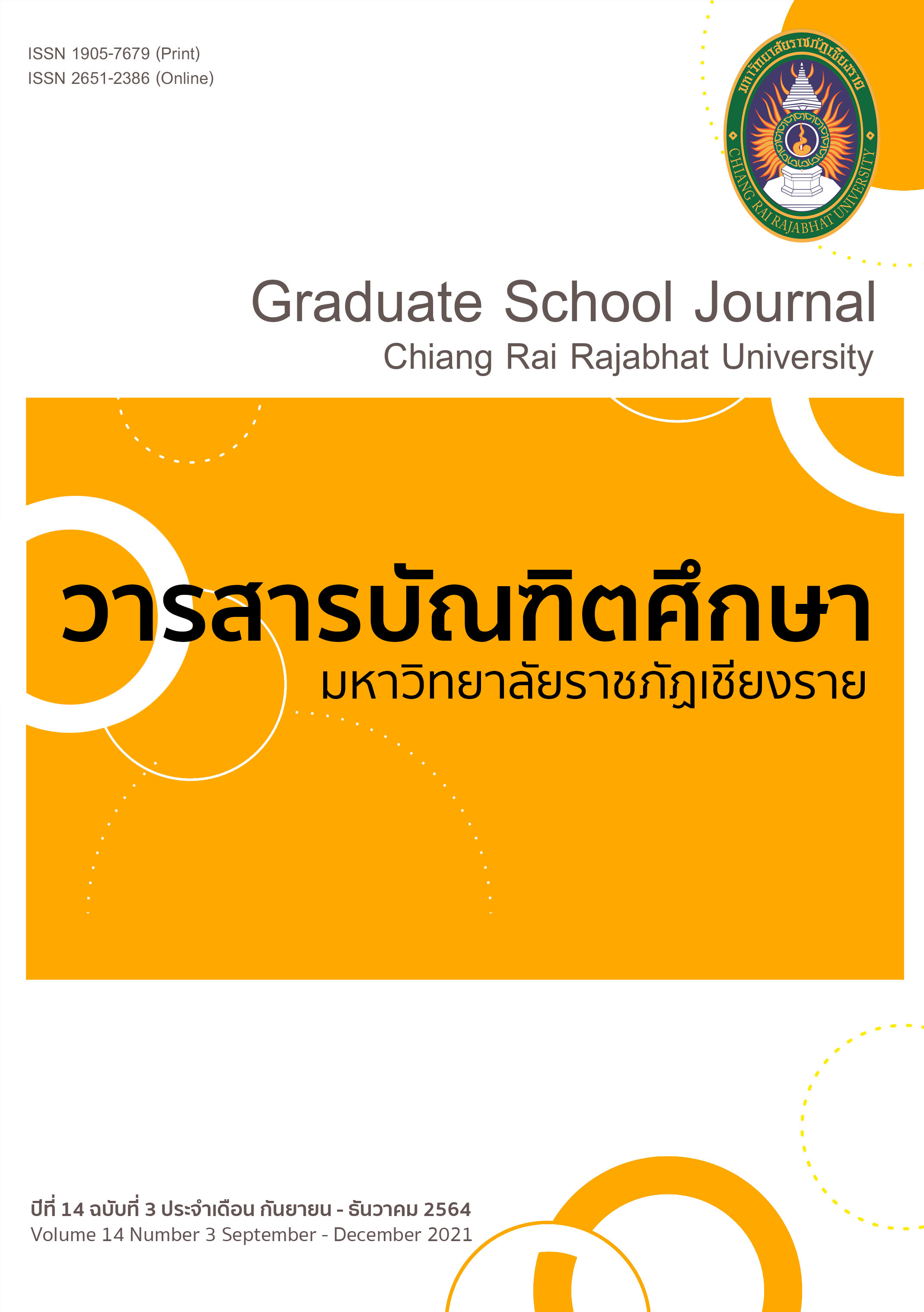The Factors Effecting to Trekking Tourism in the Upper Northern Region 2 of Thailand
Main Article Content
บทคัดย่อ
This study is aims to identify the factors effecting of trekking tourism management in the upper northern region 2 of Thailand and the trekking tourist elements influencing trekking tourism management in the upper north 2 Chiang Rai, Phayao, Phrae, and Nan. The samples used in the research came from officers from relates organization and private sectors include trekking tour operators and trekking guide. The trekking tourism community representatives consisted of 20 people. The research tool included the semi-structured interview based on the trekking standards use a chain of data collection methods. The information used to analyze the data are descriptive statistic. The study results showed that the factors of trekking tourism in the upper North 2 consist by 1) Trekking factors effecting in the area (Chiang Rai, Phayao, Phrae and Nan Provinces) and 2) the perception of trekking tourists to satisfaction of tourist needs
Article Details
บทความที่ได้รับการตีพิมพ์เป็นลิขสิทธิ์ของวารสารมหาวิทยาลัยราชภัฎเชียงราย
ข้อความที่ปรากฏในบทความแต่ละเรื่องในวารสารวิชาการเล่มนี้เป็นความคิดเห็นส่วนตัวของผู้เขียนแต่ละท่านไม่เกี่ยวข้องกับมหาวิทยาลัยราชภัฎเชียงราย และคณาจารย์ท่านอื่นๆในมหาวิทยาลัยฯ แต่อย่างใด ความรับผิดชอบองค์ประกอบทั้งหมดของบทความแต่ละเรื่องเป็นของผู้เขียนแต่ละท่าน หากมีความผิดพลาดใดๆ ผู้เขียนแต่ละท่านจะรับผิดชอบบทความของตนเองแต่ผู้เดียว
เอกสารอ้างอิง
Alves, F. J. S. (2008). Underwater archaeoological trails. Musuem International, 60, 81-90.
Avijit, Gupta, (2005). The physical geography of Southeast Asia, Oxford: New York: Oxford University Press.
Blamey, R. (1998). Contingent valuation and the activation of environmental norms. Ecological Economics, 24(1), 47–72.
Buckley, R. (2007). Adventure tourism management. International Centre for Ecotourism Research. Gold Coast, Australia: Griffith University.
Brockleman, W. Y., & Dearden, P. (1990). The Role of Nature Trekking in Conservation: A Case-study in Thailand. Environmental Conservation, 17(02), 141.
Centre for the Promotion of Imports from Developing Countries. (2018). Trekking tourism from Europe to Asia. Netherland: CBI Ministry of Foreign Affairs.
Clarke, R.N., & Stankey, G.H. (1979). The recreation opportunity spectrum: A framework for planning, management and research. In USDA forest service, general technical report PNW-98 (pp.4-28). Portland: Pacific Northwest Research Station.
Dowling, R.K. (1996). Ecotourism in Thailand. Annals of Tourism Research, 23(2), 488-490.
Department of National Park (Thailand). (2015). National parks in Thailand, Bangkok. Thailand.
Epler Wood, Megan. (2002). Ecotourism: Principles, Practices and Policies for Sustainability. Paris: UN Publications.
Kajtna, T. and P. Klinar. (2017). Personality and sensation seeking in high-risk sports. Acta Gymnica, 47(1), 41-48.
Megan Elper Wood. (2002). Ecotourism: Principles, Practices & Policies for Sustainability. Nairobi: United Nations Environment Program.
Ministry of Culture, Tourism and Civil Aviation. (2017). Great Himalaya trails standards guidelines. Kathmandu: Ministry of Culture, Tourism and Civil Aviation.
Prahalad, C. K., & Ramaswamy, V. (2000). Co-Opting Customer Competence. Harvard Business Review, 78(1), 79-90.
PranilKumar, U. (2018). Sustainable management of trekking trails for the adventure tourism in mountains : A study of Nepal’s Great Himalaya Trails, Journal of Tourism & Adventure, 1(1), 1-31.
Saqib, N. (2018). Impediments to development of tourism industry in Jammu and Kashmir. Journal of Multidisciplinary Subjects, 12(2), 615-632.
Sin Sarobol et al. (2004). Community tourism. Community research, Science and Technology Research of Thailand, 57(1), 15-21.
Williams, P. G. and Soutar, N. (2009). Value , satisfaction and behavioural intentions in an adventure tourism context. Annal of Tourism research, 36(3), 413-438.
Zuckerman, M. (2009). Sensation seeking. Handbook of individual differences in social behavior, The Guildford Press. New York.


